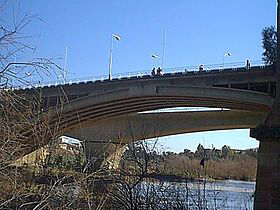MONOGRAPH OF THE WILAYA
WILAYA Of CHLEF
ADMINISTRATIVE ORGANIZATION
Number of Daïras : 13.
Number of communes : 35.
|
DAIRAS |
COMMUNES |
|
Chlef |
Chlef-Sendjas-Oum Drou |
|
Oued Fodda |
Oued Fodda-Beni Rached-Ouled Abbes |
|
El Karimia |
El Karimia -Harchoun -Beni Bouatteb |
|
Zeboudja |
Zeboudja -Benairia -Bouzghaia |
|
Ouled Fares |
Ouled Fares-Chettia-Labiadh Medjadja |
|
Boukader |
Boukader-Oued Sly –Sobha |
|
Ouled Ben Aek |
Ouled Ben aek -El Hadjadj |
|
Ain Merane |
Ain Merane -Herenfa |
|
Taougrit |
Taougrit -Dahra |
|
Ténès |
Ténès -Sidi Akkacha -Sidi Abderrahmane |
|
Abou el Hassen |
Abou el Hassen-Talassa-Tadjena |
|
El Marsa |
El Marsa-Moussadek |
|
Beni Haoua |
Beni Haoua-Breira-Oued Goussine |
DEMOGRAPHIC SITUATION AND SURFACE
The wilaya account a population of 1098166 inhabitants. (Estimate) with an total surface area of 4074 km2.
GEOGRAPHICAL LOCATION (Relief Climate…)
The wilaya of Chlef is located in the Such Westerner at 200 km (up to 300 km for the communes of the North-West) at the west of Algiers. It is delimited 4:
· In north, by the Mediterranean;
· In the south, by the wilaya of Tissemsilt;
· In the east, by the wilayas of Ain Defla and Tipaza;
· In the west, by the wilayas of Mostaganem and Relizane.
RELIEF
The wilaya is formed by four geographical units:
- A Mediterranean coast extending on 120 km;
- The chain of Dahra in north;
- Mounts of Ouarsenis in the south;
- The plain of Cheliff enters the two mountainous units.
CLIMATE
The wilaya is characterized by a sub-wet Mediterranean climate in the Northern part and a continental climate in the South, cold in winter and heat in summer.
HYDROGRAPHY
Chelif is most important water court, it crosses Wilaya of the East to the West. Wilaya has two stoppings Oued Fodda and Sidi Yakoub.

PLUVIOMETIE
Average annual pluviometry is: 40,06 mm per month.
TEMPERATURE
The temperature reaches its maximum in August with more 38,80°C in summer, its minimum in January with +06,1°C in winter.
NATURAL SOURCES
AGRICULTURE
the agricultural activity is dominating dant the wilaya of chlef from the ferlility of its arable lands whose plains extend until the wilaya from relizane.
Arboriculture appears in the foreground, in particular by the culture of orange, and various the varieties of vegetables.
ECONOMIC POTENTIALITIES
ECONOMIC INFRASTRUCTURES, ADMINISTRATIVE AND SOCIAL
HIGHWAY NETWORK
Composed primarily by:
- Trunk roads : 304 Km
- Ways of Wilaya : 560 Km
- Communal Ways: 1878.80 Km
EDUCATION
The wilaya has elementary schools, middle schools and colleges as well as TCP, NISTP and additional TCP.
HEALTH
The wilaya has hospital, polyclinics and treatment rooms.
POTENTIALITIES AND TOURIST ACTIVITIES
On the cultural level, the wilaya brought its batch to the enrichment of civilization arabo-Moslem woman, in the writings and lesson of the scholars and scientists such as Ibrahim Ibn Yekhlef Ibn Abdessalem Abou Eshak El Tensi, Mohamed Ibn Abd El Djallil, Abou Abdellah El Tensi, Abou El Hassen Ibn Yekhlef El Tensi, rustic Sidi Me hamed Ben bahloul, Ali El Medjadji (940-1002 H), Abderrahman El Medjadji.
HISTORIC
The territory of the wilaya was very in the past inhabited, as the vestiges testify some to various prehistoric eras. The seniority of the Berber settlement is marked at the exit of the Neolithic era Ténès (Kertes) was a counter created by Phéniciens in VIIIème century before J.C.
The coastal region and the plains were subject to the Carthaginian influence. In IIIème century before J.C, the wilaya was with the borders of the kingdoms Amazigh Massaesyle and Massyle, undergoing the domination sometimes one, sometimes of the other, until the unification of Numidie by Massinissa. Already before the direct occupation, the Romans with the emperor Auguste Octave found after 33 years before J.C - a colony with Ténès (karténna) with veterans of the II ème Roman Région.

With Juba II, it was the agricultural source of richness for Maurétanie Cesarean. The Roman occupation touched the coast and the plains; the mountain tribes of Dahra and Ouarsenis remained independent. The town of Chlef (Castellum Tingitanum) was a military camp to supervise these savage tribes. A basilica was built there with the III ème century after J.C, with the holy bishop Réparatus.
At the 5th century after J.C, the territory of Wilaya constituted the main component of the kingdom independent Amazigh of Ouarsenis (Djeddars).
With Futuhates of Islam, the Moslems conquered the area between 675/.682 after J.C (53/62 the hégire) under the command of the military chief Abou El Mouhadjir Dinar. Populated by the tribes Zenâta and Meghraoua mainly, it passed successively under the authority of B' nor Rostom, Beni Obeide, of Beni Hammad, Mourabitine, Mouahidine and finally of Beni Ziane. At the beginning of I0éme century, Ténès accommodated a strong immigration of Andalusians. With the decline of the kingdom of Blessed Ziane, Ténès became a republic independent with Moulay Ben Abdellah and Hamid El Abd of the Arab tribe of Sawade before being invaded by the Spaniards, then delivered by the brothers Turkish Aroudj and Kheir Eddine in 1517.

During the Turkish time, the area was subjected and divided into several administrative units (Dar El Soltan for Ténès and the coast, Beylick of Titteri for the East part and beylick of the West for the remainder with Khalifa of Cheliff).
After 1830 the area underwent the French occupation after a savage resistance (carried out in the plains by the Emir Abdelkader and represented with dignity in Dahra and Ouarsenis by Mohamed Ben Abdellah says Boumaaza and after massacres of population perpetrated by the generals sanguinary and sadly famous (saint Arnaud, Pelissier, Cavaignac…) and in the enfumades of the caves of Dahra which are perennialized by colonial tables of paintings.
During the revolution armed of November 1st, 1954, the wilaya of chlef belonged to the second area of the wilaya IV and contributed by the sacrifice of its worthy sons to the release of the country and independence.








